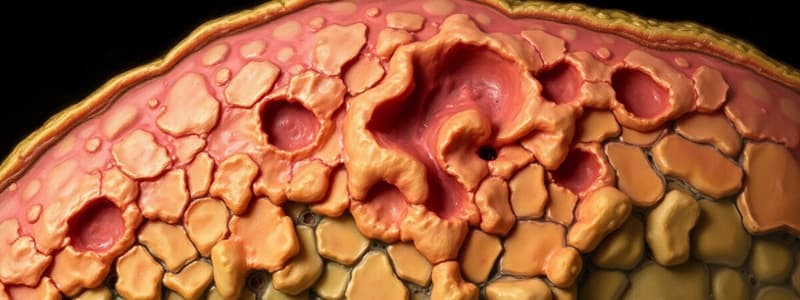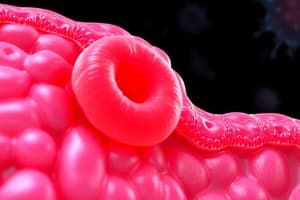Podcast
Questions and Answers
What is the primary purpose of the remodeling phase in connective tissue repair?
What is the primary purpose of the remodeling phase in connective tissue repair?
To increase wound strength and contract it through the formation of new epithelium and realignment of collagen fibers.
How long after an injury does the remodeling process typically begin, and for how long can it continue?
How long after an injury does the remodeling process typically begin, and for how long can it continue?
It begins about 21 days after an injury and can continue for a year or more.
What changes occur to collagen types during the remodeling phase, and why is this important?
What changes occur to collagen types during the remodeling phase, and why is this important?
Collagen is remodeled from type III to type I, which is important for creating a more organized and stronger collagen structure that mimics native tissue.
What role do matrix metalloproteinases play in connective tissue remodeling?
What role do matrix metalloproteinases play in connective tissue remodeling?
Discuss the factors influencing the strength recovery of well-sutured skin wounds after three months.
Discuss the factors influencing the strength recovery of well-sutured skin wounds after three months.
What are the two primary processes involved in tissue repair, and how do they differ?
What are the two primary processes involved in tissue repair, and how do they differ?
What role do adult stem cells play in tissue regeneration?
What role do adult stem cells play in tissue regeneration?
Identify the factors that influence the healing outcomes after tissue injury.
Identify the factors that influence the healing outcomes after tissue injury.
Explain the difference between labile and stable tissues in the context of cell proliferation.
Explain the difference between labile and stable tissues in the context of cell proliferation.
What is fibrosis, and under what circumstances does it typically occur?
What is fibrosis, and under what circumstances does it typically occur?
Discuss the significance of angiogenesis in tissue repair.
Discuss the significance of angiogenesis in tissue repair.
How does the chronicity of inflammation affect the tissue healing process?
How does the chronicity of inflammation affect the tissue healing process?
What is the fibroproliferative response, and what role does it play in tissue healing?
What is the fibroproliferative response, and what role does it play in tissue healing?
What are some examples of permanent tissues in the human body?
What are some examples of permanent tissues in the human body?
How do labile tissues regenerate after injury?
How do labile tissues regenerate after injury?
What is the unique regenerative capacity of the liver?
What is the unique regenerative capacity of the liver?
Describe the role of growth factors in tissue regeneration.
Describe the role of growth factors in tissue regeneration.
What initiates the process of scar formation following tissue injury?
What initiates the process of scar formation following tissue injury?
What is the primary cellular response during the inflammatory phase of repair?
What is the primary cellular response during the inflammatory phase of repair?
What happens to parenchyma composed of stable cell populations during injury?
What happens to parenchyma composed of stable cell populations during injury?
How quickly does granulation tissue form after an injury?
How quickly does granulation tissue form after an injury?
What is the consequence of extensive tissue damage even in tissues with regenerative capacity?
What is the consequence of extensive tissue damage even in tissues with regenerative capacity?
In the context of renal injury, what compensatory mechanism occurs?
In the context of renal injury, what compensatory mechanism occurs?
What is the purpose of endothelial cell proliferation during wound healing?
What is the purpose of endothelial cell proliferation during wound healing?
Describe the role of fibroblasts in the formation of granulation tissue.
Describe the role of fibroblasts in the formation of granulation tissue.
How does the composition of granulation tissue change as healing progresses?
How does the composition of granulation tissue change as healing progresses?
What growth factor influences fibroblast migration and proliferation in connective tissue deposition?
What growth factor influences fibroblast migration and proliferation in connective tissue deposition?
Explain the significance of vascular regression in scar formation.
Explain the significance of vascular regression in scar formation.
What are myofibroblasts, and what role do they play in wound healing?
What are myofibroblasts, and what role do they play in wound healing?
Identify the histological features of granulation tissue.
Identify the histological features of granulation tissue.
What causes edema in healing wounds during angiogenesis?
What causes edema in healing wounds during angiogenesis?
How does collagen deposition affect wound strength?
How does collagen deposition affect wound strength?
What is the appearance of granulation tissue in a clinical setting?
What is the appearance of granulation tissue in a clinical setting?
Flashcards
Tissue Repair
Tissue Repair
The ability of a tissue to restore its normal structure and function after injury.
Tissue Regeneration
Tissue Regeneration
The process of replacing damaged tissue with the same type of cells, restoring normal function.
Tissue Scarring
Tissue Scarring
The process of replacing damaged tissue with scar tissue, composed mainly of collagen fibers. This results in a loss of normal function.
Adult Stem Cells
Adult Stem Cells
Signup and view all the flashcards
Angiogenesis
Angiogenesis
Signup and view all the flashcards
Labile Tissues
Labile Tissues
Signup and view all the flashcards
Stable Tissues
Stable Tissues
Signup and view all the flashcards
Fibrosis
Fibrosis
Signup and view all the flashcards
Permanent Tissues
Permanent Tissues
Signup and view all the flashcards
Repair by Scarring
Repair by Scarring
Signup and view all the flashcards
Hemostatic Plug Formation
Hemostatic Plug Formation
Signup and view all the flashcards
Inflammation
Inflammation
Signup and view all the flashcards
Tissue Stem Cells
Tissue Stem Cells
Signup and view all the flashcards
Granulation Tissue
Granulation Tissue
Signup and view all the flashcards
Liver Regeneration
Liver Regeneration
Signup and view all the flashcards
Wound Cleansing
Wound Cleansing
Signup and view all the flashcards
Scar Formation
Scar Formation
Signup and view all the flashcards
Cell Proliferation
Cell Proliferation
Signup and view all the flashcards
Fibroblasts
Fibroblasts
Signup and view all the flashcards
TGF-β
TGF-β
Signup and view all the flashcards
Myofibroblasts
Myofibroblasts
Signup and view all the flashcards
Connective Tissue Deposition
Connective Tissue Deposition
Signup and view all the flashcards
Vascular Regression
Vascular Regression
Signup and view all the flashcards
Wound Remodeling
Wound Remodeling
Signup and view all the flashcards
Matrix metalloproteinases (MMPs)
Matrix metalloproteinases (MMPs)
Signup and view all the flashcards
Type III Collagen
Type III Collagen
Signup and view all the flashcards
Type I Collagen
Type I Collagen
Signup and view all the flashcards
Study Notes
Tissue Regeneration vs. Repair
- Repair or healing restores tissue architecture and function after injury
- Two processes: regeneration (restoring normal tissue) and scarring (fibrous tissue deposition)
- Regeneration occurs via proliferation of surviving cells or tissue stem cells (e.g., bone fracture, superficial skin wound)
- Scarring occurs when regeneration is limited due to severe injury or extensive tissue damage
- Fibrosis (organization): a process where fibroproliferative response deposits collagen & ECM (scar), instead of restoring
- Healing outcome depends on damaged tissue's proliferative capacity, ECM integrity, and inflammation chronicity
Cell and Tissue Regeneration
- Multiple cell types proliferate during tissue repair, including
- Remnant injured tissue cells
- Endothelial cells (angiogenesis, nutrient provision)
- Fibroblasts (scar ECM production)
- Labile tissues continually divide, with cell replacement via mature cells or tissue stem cell maturation (e.g., bone marrow hematopoietic cells, most surface epithelia)
- Stable tissues have minimal baseline division, dividing after injury or tissue loss (e.g., solid tissue parenchyma, endothelial cells, smooth muscle cells)
- Permanent tissues are terminally differentiated, non-proliferative in postnatal life (e.g., cardiomyocytes, most neurons)
Mechanisms of Tissue Regeneration
- In labile tissues, injured cells are replaced by surviving cells and tissue stem cell differentiation
- Proliferation driven by growth factors from macrophages, epithelial, and stromal cells
- Blood cell loss is corrected via hematopoietic stem cell proliferation, stimulated by colony-stimulating factors
- Tissues with stable cells (pancreas, adrenal, thyroid, lung) have some regenerative capacity; nephrectomy results in compensatory hyperplasia/hypertrophy of some kidney cells
Liver Regeneration
- Liver regeneration occurs via hepatocyte proliferation and progenitor cell repopulation
- Even with regeneration capacity, extensive tissue damage can lead to incomplete repair accompanied by scar formation (e.g., liver abscess)
Steps in Scar Formation
- Repair begins within 24 hours of injury; granulation tissue evident in 3-5 days
- Repair involves sequential processes following injury:
- Hemostatic plug formation (platelets, fibrin)
- Inflammation (complement, chemokines, neutrophils, monocytes)
- Cell proliferation (epithelial cells, endothelial cells, pericytes, fibroblasts)
- Granulation tissue formation (fibroblasts, capillaries)
- Connective tissue deposition (fibroblast migration, collagen synthesis, granulation tissue to scar)
Remodeling of Connective Tissue
- Ongoing during granulation tissue formation
- A balance of ECM protein synthesis and degradation for wound strength, collagen realignment, and scar shrinkage
- Aims to increase wound strength and contract through the formation of new epithelium and realignment and degradation of collagen fibers.
Studying That Suits You
Use AI to generate personalized quizzes and flashcards to suit your learning preferences.




